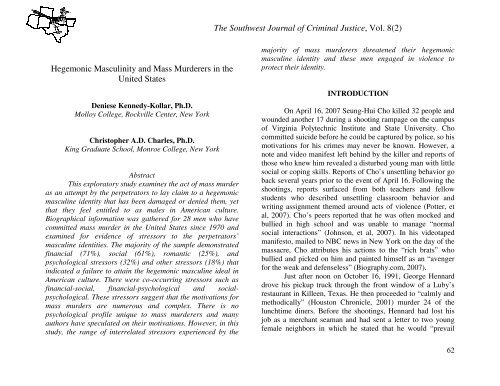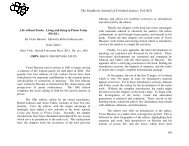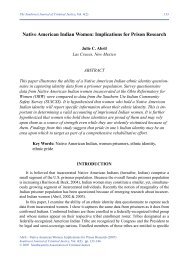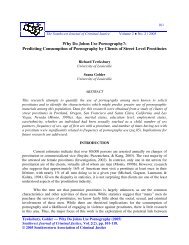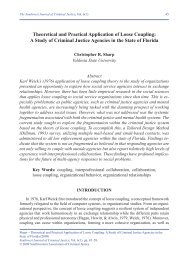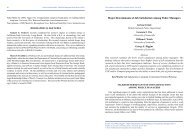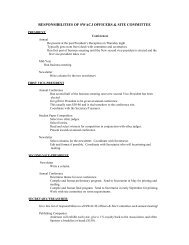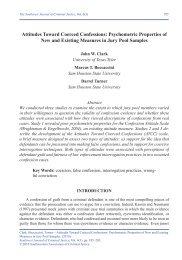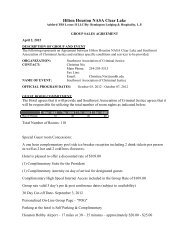Article 4 Hegemonic Masculinity and Mass Murders in ... - Swacj.Org
Article 4 Hegemonic Masculinity and Mass Murders in ... - Swacj.Org
Article 4 Hegemonic Masculinity and Mass Murders in ... - Swacj.Org
Create successful ePaper yourself
Turn your PDF publications into a flip-book with our unique Google optimized e-Paper software.
The Southwest Journal of Crim<strong>in</strong>al Justice, Vol. 8(2)<strong>Hegemonic</strong> <strong>Mascul<strong>in</strong>ity</strong> <strong>and</strong> <strong>Mass</strong> Murderers <strong>in</strong> theUnited StatesDeniese Kennedy-Kollar, Ph.D.Molloy College, Rockville Center, New YorkChristopher A.D. Charles, Ph.D.K<strong>in</strong>g Graduate School, Monroe College, New YorkAbstractThis exploratory study exam<strong>in</strong>es the act of mass murderas an attempt by the perpetrators to lay claim to a hegemonicmascul<strong>in</strong>e identity that has been damaged or denied them, yetthat they feel entitled to as males <strong>in</strong> American culture.Biographical <strong>in</strong>formation was gathered for 28 men who havecommitted mass murder <strong>in</strong> the United States s<strong>in</strong>ce 1970 <strong>and</strong>exam<strong>in</strong>ed for evidence of stressors to the perpetrators’mascul<strong>in</strong>e identities. The majority of the sample demonstratedf<strong>in</strong>ancial (71%), social (61%), romantic (25%), <strong>and</strong>psychological stressors (32%) <strong>and</strong> other stressors (18%) that<strong>in</strong>dicated a failure to atta<strong>in</strong> the hegemonic mascul<strong>in</strong>e ideal <strong>in</strong>American culture. There were co-occurr<strong>in</strong>g stressors such asf<strong>in</strong>ancial-social, f<strong>in</strong>ancial-psychological <strong>and</strong> socialpsychological.These stressors suggest that the motivations formass murders are numerous <strong>and</strong> complex. There is nopsychological profile unique to mass murderers <strong>and</strong> manyauthors have speculated on their motivations. However, <strong>in</strong> thisstudy, the range of <strong>in</strong>terrelated stressors experienced by themajority of mass murderers threatened their hegemonicmascul<strong>in</strong>e identity <strong>and</strong> these men engaged <strong>in</strong> violence toprotect their identity.INTRODUCTIONOn April 16, 2007 Seung-Hui Cho killed 32 people <strong>and</strong>wounded another 17 dur<strong>in</strong>g a shoot<strong>in</strong>g rampage on the campusof Virg<strong>in</strong>ia Polytechnic Institute <strong>and</strong> State University. Chocommitted suicide before he could be captured by police, so hismotivations for his crimes may never be known. However, anote <strong>and</strong> video manifest left beh<strong>in</strong>d by the killer <strong>and</strong> reports ofthose who knew him revealed a disturbed young man with littlesocial or cop<strong>in</strong>g skills. Reports of Cho’s unsettl<strong>in</strong>g behavior goback several years prior to the event of April 16. Follow<strong>in</strong>g theshoot<strong>in</strong>gs, reports surfaced from both teachers <strong>and</strong> fellowstudents who described unsettl<strong>in</strong>g classroom behavior <strong>and</strong>writ<strong>in</strong>g assignment themed around acts of violence (Potter, etal, 2007). Cho’s peers reported that he was often mocked <strong>and</strong>bullied <strong>in</strong> high school <strong>and</strong> was unable to manage “normalsocial <strong>in</strong>teractions” (Johnson, et al, 2007). In his videotapedmanifesto, mailed to NBC news <strong>in</strong> New York on the day of themassacre, Cho attributes his actions to the “rich brats” whobullied <strong>and</strong> picked on him <strong>and</strong> pa<strong>in</strong>ted himself as an “avengerfor the weak <strong>and</strong> defenseless” (Biography.com, 2007).Just after noon on October 16, 1991, George Hennarddrove his pickup truck through the front w<strong>in</strong>dow of a Luby’srestaurant <strong>in</strong> Killeen, Texas. He then proceeded to “calmly <strong>and</strong>methodically” (Houston Chronicle, 2001) murder 24 of thelunchtime d<strong>in</strong>ers. Before the shoot<strong>in</strong>gs, Hennard had lost hisjob as a merchant seaman <strong>and</strong> had sent a letter to two youngfemale neighbors <strong>in</strong> which he stated that he would “prevail62
The Southwest Journal of Crim<strong>in</strong>al Justice, Vol. 8(2)over the female vipers <strong>in</strong> those two r<strong>in</strong>ky-d<strong>in</strong>k towns <strong>in</strong> Texas”(Terry, 1991). It appeared that Hennard may have targetedwomen <strong>in</strong> his rampage. Fourteen of the victims were women<strong>and</strong> one witness reported that dur<strong>in</strong>g the shoot<strong>in</strong>g spreeHennard had shouted “Wait 'til those f---<strong>in</strong>g women <strong>in</strong> Beltonsee this! I wonder if they'll th<strong>in</strong>k it was worth it!'' (Squitieri &Howlett, 1991, p.1A).The motivations for mass murders such as thosecommitted by Cho <strong>and</strong> Hennard are numerous <strong>and</strong> complex.There is no psychological profile unique to mass murderers <strong>and</strong>many authors have speculated on their motivations. The <strong>in</strong>tenserage these men must have felt is undeniable, but it rema<strong>in</strong>sunclear why they chose to express that rage <strong>in</strong> rampagesaga<strong>in</strong>st <strong>in</strong>nocent byst<strong>and</strong>ers who never did them any personalwrong. “<strong>Mass</strong> murderers tend to be frustrated, angrypeople…(whose) lives have been failures by theirst<strong>and</strong>ards…(<strong>and</strong> who tend to select targets that are) symbolicof their discontent…The mass murder is their chance to geteven, to dom<strong>in</strong>ate others, to take control, to call the shots, <strong>and</strong>to ga<strong>in</strong> recognition” (Bartol & Bartol, 2005, p. 344-345). Thispaper exam<strong>in</strong>es the act of mass murder as an attempt by theperpetrators to lay claim to a hegemonic mascul<strong>in</strong>e identity thathas been damaged or denied them, yet one they feel entitled to,as males <strong>in</strong> American culture.<strong>Mass</strong> Murderers<strong>Mass</strong> murder is def<strong>in</strong>ed as “the sudden, <strong>in</strong>tentionalkill<strong>in</strong>g of more than one person <strong>in</strong> the same location <strong>and</strong> at thesame time, usually by a s<strong>in</strong>gle person” (Palermo & Ross, 1999,p.8). Turvey (2008) notes that the problem of mass murders isnot unique to the United States. However, Hamamoto (2002)argues that the United States produce most of the world’s massmurderers because of a “blow back” by civilians script<strong>in</strong>gviolence <strong>in</strong> a hyper-militarised America which started with the<strong>in</strong>creas<strong>in</strong>g military adventures after World War II. Research onmass murder is relatively limited when compared to otherforms of multiple homicide (Bowers, et al, 2010), yet severalauthors have identified descriptive characteristics, patterns, <strong>and</strong>typologies that differentiate mass murder from other forms ofmultiple murder <strong>and</strong> from murder <strong>in</strong> general (Fox & Lev<strong>in</strong>,2012, Bowers, et al, 2010, Bartol & Bartol, 2011).<strong>Mass</strong> murderers tend to differ from murderers <strong>in</strong>general <strong>in</strong> a number of ways. They are more likely to be older,male, <strong>and</strong> white than the typical homicide perpetrator (Fox <strong>and</strong>Lev<strong>in</strong>, 2012). Their victims are also likely to differ fromgeneral homicide victims. Accord<strong>in</strong>g to Fox <strong>and</strong> Lev<strong>in</strong> (2012)victims of mass murderers are more often white (approximately70% compared to about 50% of general homicide victims) <strong>and</strong>female (43% compared to 23%) than general homicide victims.These men tend to have a history of personal <strong>and</strong> professionalfailures <strong>and</strong> tend to externalize the blame for those failures onothers or society at large (Fox <strong>and</strong> Lev<strong>in</strong>, 2012, Bowers et al,2010).There are three common types of mass murderers, thepseudocomm<strong>and</strong>o, set-<strong>and</strong>-run or hit-<strong>and</strong>-run killer, <strong>and</strong> thefamily annihilator (Bowers, et al, 2010; Knoll IV, 2010a,2010b). Family annihilators are often family patriarchs whomurder many members of their own families due to mount<strong>in</strong>gfeel<strong>in</strong>gs of frustration, desperation, <strong>and</strong> hopelessness stemm<strong>in</strong>gfrom numerous <strong>and</strong> mount<strong>in</strong>g failures <strong>and</strong> disappo<strong>in</strong>tments(Fox & Lev<strong>in</strong>, 2012, Bowers, et al 2010). Thepseudocomm<strong>and</strong>o type often have a long-st<strong>and</strong><strong>in</strong>g fasc<strong>in</strong>ationwith weapons <strong>and</strong> who plan their mass murders to settle real orimag<strong>in</strong>ed grudges with <strong>in</strong>dividuals who have harmed them orwith society at large (Fox & Lev<strong>in</strong>, 2012, Bowers, et al 2010).A set-<strong>and</strong>-run mass murderer uses techniques which allow him63
The Southwest Journal of Crim<strong>in</strong>al Justice, Vol. 8(2)to kill many people while avoid<strong>in</strong>g capture, such as producttamper<strong>in</strong>g,bomb<strong>in</strong>gs, are arson fires (Fox & Lev<strong>in</strong>, 2012,Bowers, et al 2010). Fox <strong>and</strong> Lev<strong>in</strong> (2012) have also offered atypology of mass murderers based upon the killer’s primarymotivation – power, revenge, loyalty, profit, <strong>and</strong> terror.The Motivation for <strong>Mass</strong> MurderThere are several explanations that accounts for thebehavior of mass murderers. One is the stra<strong>in</strong> theoryperspective, which argues that a mass murderer goes throughseveral sequential stages. They experience chronic stra<strong>in</strong>,result<strong>in</strong>g from long term frustrations start<strong>in</strong>g <strong>in</strong> childhood oradolescence which isolates them. Over time, they experienceuncontrolled stra<strong>in</strong>, because of a lack of pro-social supportwhich <strong>in</strong>fluences how, a real or imag<strong>in</strong>ed devastat<strong>in</strong>g <strong>and</strong>negative major short-term life event, is constructed. Acutestra<strong>in</strong> follows, which leads to the plann<strong>in</strong>g stage that <strong>in</strong>volvesfantasies to rega<strong>in</strong> control of the situation, through a mascul<strong>in</strong>esolution which is then actualized (Lev<strong>in</strong> & Madfis, 2009).Mov<strong>in</strong>g beyond the stra<strong>in</strong> theory, it is also believed that massmurderers are motivated by loyalty, terror, profit, power <strong>and</strong>revenge (Fox & Lev<strong>in</strong>, 2012).Although there is no profile unique to mass murderers,they display strong paranoid traits (Stone, 2007). Thispsychopathological explanation is also supported by Melroy, etal (2004) who f<strong>in</strong>d that mass murderers are reclusive peoplewho suffer from psychiatric disturbances. They also havepersonality traits that predispose them to act out. Some of thepredispos<strong>in</strong>g factors are a “warrior mentality” <strong>and</strong> a fasc<strong>in</strong>ationwith war <strong>and</strong> weapons. Hempel, Meloy <strong>and</strong> Richards (1999)also f<strong>in</strong>d that some mass murderers suffer from depression orparanoia <strong>and</strong> the death toll is higher when they are psychotic.Similarly, White-Harmon (2001) f<strong>in</strong>ds that the majority ofmass murderers were suffer<strong>in</strong>g from a mental disorder. Thepsychopathology perspective is also supported by Palermo(1997) who speaks of a “berserk syndrome.” The underly<strong>in</strong>gfactors of this syndrome are hostile feel<strong>in</strong>gs towards society,high narcissism, an <strong>in</strong>jured ego with the potential murderersearch<strong>in</strong>g for a sense of self through <strong>in</strong>famy <strong>and</strong> the assertionof self, that provides catharsis (Palermo, 1997).There is a contrary view, which sees the crazed killerexplanation which depicts the mass murderer as anunemployed loner who is psychotic, as a myth which should bedispelled. Generally, mass murderers are employed with amarried or unmarried partner (Turvey, 2008). The psycho-mythoccurs because the mass murders break the basic societalnorms <strong>and</strong> rules around which the community coalesces, sothey are seen to be abnormal when they are quite normal (Fox& Lev<strong>in</strong>, 2005). Rarely is the mass murderer a crazy killer(Kelleher, 1997). Also, the hypothesis of a subculture ofviolence that is used to expla<strong>in</strong> crim<strong>in</strong>al behavior should not beapplied to mass murderers. A comparison of mass slay<strong>in</strong>gswith s<strong>in</strong>gle-victim homicides reveal that mass murderers areord<strong>in</strong>ary <strong>and</strong> rational people who share the same characteristicswith the average American (Lev<strong>in</strong> & James, 1983). Theforego<strong>in</strong>g controversy about the mental state of massmurderers, suggest that they should be seen as people who are<strong>in</strong>fluenced by a complex set of <strong>in</strong>terrelated factors <strong>and</strong> haveimplications for forensic mental health practitioners (Aitken, etal, 2008; Kelleher, 1997). The trigger for the murderous rage isusually deep frustration because of a major personal loss ormajor rejection such as the loss of a job or a failed <strong>in</strong>timatepartner relationship <strong>in</strong> a few days or hours before the murdersare committed (Hempel, Melroy & Richards, 1999; Melroy, etal, 2004; Palermo, 1997).64
The Southwest Journal of Crim<strong>in</strong>al Justice, Vol. 8(2)<strong>Hegemonic</strong> <strong>Mascul<strong>in</strong>ity</strong><strong>Hegemonic</strong> mascul<strong>in</strong>ity is the socially supported <strong>and</strong>dom<strong>in</strong>ant mascul<strong>in</strong>ity, which <strong>in</strong>forms normative male behavior<strong>and</strong> unequal gender practices seen <strong>in</strong> the subord<strong>in</strong>ation ofwomen <strong>in</strong> the society. This dom<strong>in</strong>ant mascul<strong>in</strong>ity which isassociated with power, high status, authority, heterosexism <strong>and</strong>physical toughness, <strong>and</strong> legitimizes patriarchy, not onlysubord<strong>in</strong>ates fem<strong>in</strong><strong>in</strong>ities but also other mascul<strong>in</strong>ities deemedto be weaker <strong>in</strong> the society’s gendered order (Beasely, 2008;Connell, 1995; Lusher & Rob<strong>in</strong>s, 2009). <strong>Hegemonic</strong>mascul<strong>in</strong>e violence is not only conf<strong>in</strong>ed to the urban milieu <strong>in</strong>the United States, because the socio-economic <strong>and</strong> politicalchanges that also take place <strong>in</strong> rural areas, lead to <strong>in</strong>ternal <strong>and</strong>external male violent expressions which are strategicpatriarchal practices used to create an imag<strong>in</strong>ed rural genderedhierarchy (Carr<strong>in</strong>gton & Scott, 2008).Some critics of the hegemonic mascul<strong>in</strong>ity thesissuggest that it does not take <strong>in</strong>to account the <strong>in</strong>equalities ofclass based power, <strong>and</strong> the political economy that produces <strong>and</strong>reproduces traditional physical male violence. This conceptualoversight means that hegemonic mascul<strong>in</strong>ity, is applied outsideof relevant historical contexts <strong>and</strong> material processes, thatmake the use of the term hegemony a misnomer <strong>and</strong> theconcept an <strong>in</strong>adequate explanatory factor for patterns of maleviolence (Hall, 2002). Moreover, the concept is also used <strong>in</strong> amonolithic way which ignores plural mascul<strong>in</strong>ities that take<strong>in</strong>to account the heterogeneity of mascul<strong>in</strong>e identity <strong>and</strong> power(Beasely, 2008). Despite these criticisms, there is anevolutionary perspective which locates mascul<strong>in</strong>e violence <strong>in</strong>the descent of man. This perspective argues that violentmascul<strong>in</strong>ity is an expression of the survival of the fittest <strong>and</strong>the drive for reproductive success which has its genesis <strong>in</strong>human ancestral environments (Polk, 1998).School is one of several social doma<strong>in</strong>s <strong>in</strong> whichhegemonic mascul<strong>in</strong>ity is created <strong>and</strong> expressed <strong>in</strong> thecontemporary era. Very few Americans l<strong>in</strong>k school shoot<strong>in</strong>gsto the gender of the shooters (which is male) althoughcrim<strong>in</strong>ologists have consistently argued that there is arelationship between mascul<strong>in</strong>ity <strong>and</strong> violence. Themascul<strong>in</strong>ity which <strong>in</strong>fluences male aggression <strong>and</strong> violence issocially constructed (Watson, 2007). In other words, the<strong>in</strong>cidences of hate crimes, bully<strong>in</strong>g <strong>in</strong> schools <strong>and</strong> schoolshoot<strong>in</strong>gs among other violent expressions of mascul<strong>in</strong>ities are<strong>in</strong>fluenced by the approaches, processes <strong>and</strong> codes of thesocietal construction of men. Schools are very much reflectionsof this social construction as the bully<strong>in</strong>g <strong>and</strong> school shoot<strong>in</strong>gsjust mentioned suggests. The ways of man mak<strong>in</strong>g, whichstarts before the pre-K level <strong>and</strong> goes up to manhood, supports<strong>and</strong> approves subtle <strong>and</strong> physical expressions of violence.Therefore, the hegemonic mascul<strong>in</strong>ity taught <strong>in</strong> Americanschools jeopardises the safety of students <strong>and</strong> the society(Serriere, 2008).The context of the <strong>in</strong>ner city streets is also used byyouth to express violent mascul<strong>in</strong>ities. Respect is central tomale identity where mascul<strong>in</strong>e street behavior is driven by acode that regulates norms surround<strong>in</strong>g how grievances <strong>and</strong>conflicts are resolved. There is also an <strong>in</strong>teraction drivenecology of danger, which is <strong>in</strong>fluenced by perceptions ofthreaten<strong>in</strong>g or deadly social <strong>in</strong>teractions with rival males,whether they have hostile <strong>in</strong>tentions <strong>and</strong> whether or not theyare will<strong>in</strong>g to use violence to hurt others (Wilk<strong>in</strong>son, 2001).The anatomy of violence is evident <strong>in</strong> the narrative of a youngmale, who was construct<strong>in</strong>g his mascul<strong>in</strong>e identity whichrequired the projection of a preferred presentation of self. Thisself presentation was achieved through creat<strong>in</strong>g boundariesabout the use of violence, the reasons for fight<strong>in</strong>g <strong>and</strong> whom65
The Southwest Journal of Crim<strong>in</strong>al Justice, Vol. 8(2)one should fight. Mascul<strong>in</strong>e characteristics were made salient<strong>in</strong> the narrative by sort<strong>in</strong>g <strong>and</strong> position<strong>in</strong>g the characters of thestory. Several vary<strong>in</strong>g depictions of other men emerged <strong>in</strong> thediscourse such as non-men, villa<strong>in</strong> <strong>and</strong> hero. The forego<strong>in</strong>gdiscourse of violence, suggests that that mascul<strong>in</strong>e identity wasconstructed <strong>and</strong> negotiated through the gendered position<strong>in</strong>g ofthe negative other (Andersson, 2008).The use of the life historymethod to underst<strong>and</strong> adolescent male violence, also suggeststhat boys use the ideals of hegemonic mascul<strong>in</strong>ity to constructtheir emerg<strong>in</strong>g manhood. This identity was buttressed <strong>in</strong> schoolby the <strong>in</strong>stitutionalized bodily <strong>and</strong> sexual practices that createdsubord<strong>in</strong>ate mascul<strong>in</strong>ity which is l<strong>in</strong>ked to sexual violence <strong>and</strong>an opposition mascul<strong>in</strong>ity which is connected to assaultiveviolence (Messerschmidt, 1999).The grow<strong>in</strong>g body of evidence <strong>in</strong> the literature thathegemonic mascul<strong>in</strong>ity is related to violence was contradictedby the f<strong>in</strong>d<strong>in</strong>gs of a study of the relationship betweenmascul<strong>in</strong>ity <strong>and</strong> violent <strong>and</strong> nonviolent situations. The f<strong>in</strong>d<strong>in</strong>gsof the study <strong>in</strong>dicate that there is no relationship betweenviolence <strong>and</strong> mascul<strong>in</strong>ity but the presence of a third party is asignificant predictor of violence (Krienert, 2000). In keep<strong>in</strong>gwith the overall trend of the data on violent mascul<strong>in</strong>ity, thepositive presence of a father <strong>in</strong> the life of a son construct<strong>in</strong>g hishegemonic mascul<strong>in</strong>e identity is a key means of prevent<strong>in</strong>g theemotional problems that triggers male violence (Pope& Englar-Carlson, 2001). The prevalence of male violence suggests thatthere is a crisis of mascul<strong>in</strong>ity which provides opportunities tostop the violence <strong>and</strong> challenge the mascul<strong>in</strong>ities supported bythe status quo (Hurst, 2001). However, mascul<strong>in</strong>e violencecont<strong>in</strong>ues unabated <strong>in</strong> the United States <strong>and</strong> the most blatantexpression of this form of violence is the action of massmurderers.The Present StudyNumerous authors discuss the importance of personal<strong>and</strong> economic failure, episodes of personal humiliation, ahistory of mount<strong>in</strong>g frustration <strong>and</strong> depression, <strong>and</strong> theexternalization of the blame for those th<strong>in</strong>gs as importantprecipitat<strong>in</strong>g factors to mass murder (Fox Lev<strong>in</strong>, 2012; Bowers,et al, 2010; Bartol & Bartol, 2011; Ramsl<strong>and</strong>, 2005). However,none have exam<strong>in</strong>ed the behavior of mass murder as anexpression of the cultural mean<strong>in</strong>g of those factors <strong>in</strong> terms ofthe perpetrator’s mascul<strong>in</strong>e identity. The purpose of thepresent research is to underst<strong>and</strong> the role of hegemonicmascul<strong>in</strong>ity <strong>in</strong> <strong>in</strong>fluenc<strong>in</strong>g some males to commit massmurders <strong>in</strong> the United States. There is no specific hypothesisbecause this an exploratory research article about hegemonicmascul<strong>in</strong>ity <strong>and</strong> mass murderers.METHODSample <strong>and</strong> ProcedureThe authors conducted a review of academic books,peer-reviewed journal articles, <strong>and</strong> reputable newspapers,magaz<strong>in</strong>es <strong>and</strong> websites <strong>and</strong> identified 28 mass murders for<strong>in</strong>clusion <strong>in</strong> the study. The criteria for selection were (1) theperpetrator was a male, (2) who committed mass murder 1 <strong>in</strong> theUnited States s<strong>in</strong>ce 1970 <strong>and</strong>, (3) had been discussed <strong>in</strong> themedia.The authors conducted a Lexis Nexis search of majorU.S. <strong>and</strong> world publications for newspaper <strong>and</strong> magaz<strong>in</strong>eaccounts of each subject <strong>in</strong> order to gather <strong>in</strong>formation abouttheir biographical characteristics. The characteristics of the1 The operational def<strong>in</strong>ition of mass murder used here<strong>in</strong> is the murder ofthree or more persons <strong>in</strong> one place <strong>and</strong> there is no rest period between themurders (Bartol & Bartol, 2010).66
The Southwest Journal of Crim<strong>in</strong>al Justice, Vol. 8(2)killer is operationally def<strong>in</strong>ed as the disposition <strong>and</strong> mentalstate of the killer that is reflected <strong>in</strong> his speech or behavior, or<strong>in</strong> witness reports, that were identified as important <strong>in</strong> thenewspaper <strong>and</strong> magaz<strong>in</strong>e reports, <strong>and</strong> the websites deal<strong>in</strong>g withthe <strong>in</strong>cident.Each case was reviewed based on the place, <strong>and</strong> deathtoll of the <strong>in</strong>cident, the characteristics of the killer, <strong>and</strong> thestressor(s) that led to the <strong>in</strong>cident. Biographical <strong>in</strong>formationwas reviewed for evidence of stressors to the perpetrator’shegemonic mascul<strong>in</strong>e identity. The stressor is operationallydef<strong>in</strong>ed as any devastat<strong>in</strong>gly negative experience, real orimag<strong>in</strong>ed, that threatened the subject’s hegemonic mascul<strong>in</strong>eidentity <strong>and</strong> <strong>in</strong>fluenced the mass murder <strong>in</strong>cident. Any suchevidence was then coded as a f<strong>in</strong>ancial stressor, a romanticstressor, a social stressor, a psychological stressor or otherstressor. Conflict<strong>in</strong>g <strong>in</strong>formation received from media accountsabout a case was addressed by choos<strong>in</strong>g the <strong>in</strong>formation whichhad the greater triangulation of sources.F<strong>in</strong>ancial stressors <strong>in</strong>cluded circumstances such as theloss of a job, persistent unemployment or <strong>in</strong>ability to ma<strong>in</strong>ta<strong>in</strong>employment, serious debt, f<strong>in</strong>ancial loss, <strong>and</strong> poor jobperformance or work-related reprim<strong>and</strong>. Romantic stressors<strong>in</strong>cluded divorce, the breakup of a relationship, <strong>and</strong> rejection ofromantic or sexual overtures. Social stressors <strong>in</strong>cludedcircumstances such as hav<strong>in</strong>g been the victim of bully<strong>in</strong>g bypeers, social ostracism or isolation, ethnic or racial harassment,<strong>and</strong> the perception of hav<strong>in</strong>g been wronged by others or society<strong>in</strong> general. Information was coded as a psychological stressor ifit <strong>in</strong>volved evidence of a history of mental illness, past orpresent treatment for mental illness, or <strong>in</strong>dications of thepresence of psychotic symptoms such as halluc<strong>in</strong>ations ordelusions at the time of the murders. Stressors that could not beclassified as one of the preced<strong>in</strong>g or cases <strong>in</strong> which no clearstressors could be identified were classified as “otherstressors”.The coded data was then analyzed to look for trends<strong>and</strong> patterns <strong>in</strong> the frequency of the occurrence of the varioustypes of stressors. Two coders were used to code the data <strong>and</strong>the <strong>in</strong>ter-coder agreement is .84 <strong>and</strong>.85.RESULTSWe identified a total of 28 mass murderers who fit thecriteria for <strong>in</strong>clusion. In all, they were responsible for themurders of 275 people, 48% of whom were female. Most of thesample, 46%, killed people they knew (family, acqua<strong>in</strong>tances,co-workers, or classmates). Another 32% killed strangers <strong>and</strong>6% killed some comb<strong>in</strong>ation of both strangers <strong>and</strong> people theyknew. The average age of the sample was 32 years. 71.4%were White, 14.3% were African American, <strong>and</strong> another 14.3%were some other race (Asian, Arab, <strong>and</strong> Native American).Some 46% were unemployed or not currently work<strong>in</strong>g (thisfigure does not <strong>in</strong>clude the 29% of the sample who were fulltime students at the time of their attacks). Also, 54% of thesample committed suicide follow<strong>in</strong>g the mass murders.As shown <strong>in</strong> Figure 1, the most frequently observedstressors were f<strong>in</strong>ancial (71%) <strong>and</strong> social (61%) <strong>in</strong> nature.67
The Southwest Journal of Crim<strong>in</strong>al Justice, Vol. 8(2)2520151050Figure 1: Distribution Frequency of StressorsDistribution Frequency of StressorsF<strong>in</strong>ancial Romantic Social Psychological OtherType of StressorThe ability to ma<strong>in</strong>ta<strong>in</strong> ga<strong>in</strong>ful employment <strong>and</strong>economic <strong>in</strong>dependence is one important element of thehegemonic mascul<strong>in</strong>e identity. In 71% of the sample, evidenceof a f<strong>in</strong>ancial stressor <strong>in</strong> the form of unemployment, seriousdebt, f<strong>in</strong>ancial loss, <strong>and</strong> poor job performance or work-relatedreprim<strong>and</strong> was found. For example, George Hennard, who shot<strong>and</strong> killed 23 people <strong>in</strong> a Texas restaurant <strong>in</strong> 1981, had lost hisjob with the Merchant Mar<strong>in</strong>es. His attempts to be re<strong>in</strong>statedhad been denied just six months prior to the shoot<strong>in</strong>gs.James Huberty killed 21 people <strong>in</strong> California <strong>in</strong> 1984.For several years preced<strong>in</strong>g the massacre, he had been unableto ma<strong>in</strong>ta<strong>in</strong> steady employment <strong>and</strong> had moved his familyaround several times. After his shoot<strong>in</strong>g spree, one witnessreported that Huberty had once commented that “if he couldnot support his family, he would ‘take everyone’ with him”(Reed, 1984). In 1999, Mark Burton went on a rampage <strong>and</strong>killed 12 people at the office of an Atlanta, Georgia day trad<strong>in</strong>gcompany. Before the shoot<strong>in</strong>gs, he had lost more than$100,000 <strong>in</strong> the stock market <strong>in</strong> just eight weeks (Krantz,1999).Another important aspect of a hegemonic mascul<strong>in</strong>eidentity is the ability to exert social dom<strong>in</strong>ance, achieve a highsocial status, comm<strong>and</strong> respect <strong>and</strong> demonstrate authority.Some 61% of the men <strong>in</strong> the sample experienced socialstressors such as bully<strong>in</strong>g by peers, social isolation orostracism, <strong>and</strong> racial or ethnic harassment.In 2007, Seung-Hui Cho killed 32 people on thecampus of Virg<strong>in</strong>ia Polytechnic Institute <strong>and</strong> State University<strong>in</strong> the worst mass murder <strong>in</strong> American history. Chodemonstrated his rage with the world <strong>in</strong> a videotaped statementthat he sent to NBC on the day of the shoot<strong>in</strong>gs(Biography.com, 2007). After the massacre, former classmatesof Cho’s gave accounts of the ridicule <strong>and</strong> ostracism heexperienced throughout his school career. He was picked-onfor his broken English, made fun of for his shyness <strong>and</strong> socialawkwardness, <strong>and</strong> physically pushed around by other students(Kennedy, 2007). Other school shooters such as Eric Harris,Dylan Klebold, Andrew Golden, <strong>and</strong> Jeffrey Weise alsosuffered from bully<strong>in</strong>g <strong>and</strong> ostracism by peers.Many subjects <strong>in</strong> the sample expressed theirperceptions of hav<strong>in</strong>g been wronged or treated unfairly byothers or by society <strong>in</strong> general. Michael McClendon, whokilled 11 people <strong>in</strong> Alabama <strong>in</strong> 2009, kept a list of people whohe felt had “done him wrong” (Bone, 2009). When Col<strong>in</strong>Ferguson killed 11 people on a commuter tra<strong>in</strong> <strong>in</strong> New York <strong>in</strong>1993, he carried with him numerous h<strong>and</strong>-written notesconta<strong>in</strong><strong>in</strong>g his grievances aga<strong>in</strong>st various people <strong>and</strong> social<strong>in</strong>stitutions that he felt had wronged him or held him back <strong>in</strong>some way (Frankel, 1993).A third important aspect of the hegemonic mascul<strong>in</strong>eidentity is the ability to demonstrate romantic/sexual success or68
The Southwest Journal of Crim<strong>in</strong>al Justice, Vol. 8(2)dom<strong>in</strong>ance. Some 25% of the sample had experienced divorce,the breakup of a relationship, <strong>and</strong>/or the rejection of romanticor sexual overtures prior to their act of mass murder. In 1988,Richard Farley killed seven <strong>and</strong> <strong>in</strong>jured five of his former coworkers<strong>in</strong> a shoot<strong>in</strong>g spree <strong>in</strong> California. One of his victimswas a woman who had rejected Farley’s numerous romanticovertures (Mathews, 1988). Another man, Bruce Pardo, killed9 people <strong>in</strong> California <strong>in</strong> 2008 follow<strong>in</strong>g his recent divorce.In addition to these stressors, many men <strong>in</strong> the sample(32%) demonstrated some type of psychological distress. This<strong>in</strong>cluded evidence of a history of mental illness, past or presenttreatment for mental illness, or <strong>in</strong>dications of the presence ofpsychotic symptoms such as halluc<strong>in</strong>ations or delusions at thetime of the murders. A prime example is George Banks. Bankskilled 13 family members <strong>and</strong> acqua<strong>in</strong>tances <strong>in</strong> Pennsylvania <strong>in</strong>1982. Dur<strong>in</strong>g his trial, defense psychiatrists testified that Bankswas a psychotic who suffered from paranoid delusions(International Justice Project, n.d.). Banks’ death sentence waslater commuted after hav<strong>in</strong>g been found <strong>in</strong>competent to beexecuted due to mental illness.Some 18% of the sample evidenced other stressors suchas drug abuse, past sexual abuse, terrorism, or whose motivesrema<strong>in</strong>ed unclear or unknown. Christopher Thomas was highon crack coca<strong>in</strong>e dur<strong>in</strong>g the 1984 massacre of two women <strong>and</strong>eight children <strong>in</strong> Brooklyn, New York. The attack was thoughtto have been precipitated by Thomas’ drug-fueled <strong>and</strong> <strong>in</strong>correctbelief that his estranged wife was engaged <strong>in</strong> an affair with aman liv<strong>in</strong>g <strong>in</strong> the house where the kill<strong>in</strong>gs took place(Associated Press, 1984). Mark Essex’s 1972 kill<strong>in</strong>g of n<strong>in</strong>epolice officers appears to have been primarily motivated by hisracial hatred of whites (Hustmyre, n.d.).Most of the sample (57%) demonstrated evidence ofmore than one type of stressor. The most frequently occurr<strong>in</strong>gconcomitant stressors were f<strong>in</strong>ancial/social (25%),f<strong>in</strong>ancial/psychological (21%), <strong>and</strong> social/psychological (21%).Several men <strong>in</strong> the sample demonstrated more than twostressors, with the most frequently occurr<strong>in</strong>g (18%) be<strong>in</strong>gf<strong>in</strong>ancial/social/psychological.DISCUSSIONThis exploratory study exam<strong>in</strong>ed the <strong>in</strong>fluence ofhegemonic mascul<strong>in</strong>ity on the violent behavior of twenty eightmass murderers <strong>in</strong> the United States s<strong>in</strong>ce 1970. The majority<strong>in</strong> the sample 71.4 % were white males <strong>and</strong> the average age ofthe men <strong>in</strong> the sample is 32 years. The forego<strong>in</strong>g f<strong>in</strong>d<strong>in</strong>gscorroborate the f<strong>in</strong>d<strong>in</strong>gs by Fox <strong>and</strong> Lev<strong>in</strong> (1998, 2012) aboutthe profile of mass murderers. A majority of the men (71%)experienced f<strong>in</strong>ancial stressors. The hegemonic mascul<strong>in</strong>eperspective suggests that it is possible that the men viewedthese stressors as threats to the self as providers for themselves<strong>and</strong>/or their families. A lack of <strong>in</strong>come (46% of the samplewere unemployed) or <strong>in</strong>sufficient f<strong>in</strong>ancial resources reducedthe men’s autonomy <strong>and</strong> <strong>in</strong>dependence <strong>and</strong> devalued theirmanhood so they may have felt they were <strong>in</strong>competentproviders for themselves <strong>and</strong>/or their families.Threats to hegemonic mascul<strong>in</strong>ity also occurredthrough some of the men’s <strong>in</strong>ability to exert social dom<strong>in</strong>ance<strong>and</strong> comm<strong>and</strong> respect through the demonstration of theirauthority. These mass murderers (61%) experienced a range ofsocial stressors such as racism <strong>and</strong> ethnocentrism, socialostracism <strong>and</strong> bully<strong>in</strong>g. These men earlier <strong>in</strong> their lives weredeviations from the hegemonic mascul<strong>in</strong>e norm. Therefore, it ispossible that they experienced the taunts, <strong>in</strong>sults <strong>and</strong> aggressivebehavior from their hegemonic mascul<strong>in</strong>e peers as sociallyeffac<strong>in</strong>g stressors. These men subsequently reduced their69
The Southwest Journal of Crim<strong>in</strong>al Justice, Vol. 8(2)frustrations by assert<strong>in</strong>g the ideal mascul<strong>in</strong>e self throughviolence. Another threat to men’s mascul<strong>in</strong>e self came from theaffront to their sense of fairness <strong>and</strong> justice. These men mayhave blamed society <strong>in</strong> general <strong>and</strong> people <strong>in</strong> particular for thewrongs they suffered rather than themselves <strong>in</strong> order to protecttheir mascul<strong>in</strong>e identity or their perceived dom<strong>in</strong>ance <strong>in</strong> thegendered hierarchy.The subord<strong>in</strong>ation <strong>and</strong> control of women are crucialaspects of the hegemonic mascul<strong>in</strong>e identity. <strong>Mass</strong> murder wasalso triggered by threats to some (25%) of the men’s ability todeterm<strong>in</strong>e <strong>and</strong> control the outcome of their <strong>in</strong>timate-partnerrelationship, start new relationships or succeed <strong>in</strong> their sexualovertures with women who account for 48% of the victims <strong>in</strong>the study. The perpetrators may have felt like weak menbecause of their failures <strong>in</strong> relationships <strong>and</strong> sexual overturesso they had to assert themselves. Mental disorder was alsoprevalent among 32% of the men which <strong>in</strong>fluenced theirmurderous rage. This f<strong>in</strong>d<strong>in</strong>g corroborates the f<strong>in</strong>d<strong>in</strong>gs ofTurvey (2008) that the crazed killer explanation is a mythbecause 68% of our sample did not suffer from a mentaldisorder. Moreover, the overwhelm<strong>in</strong>g majority of people withmental disorders <strong>in</strong> the United States do not commit massmurders. However, although mental disorders are not apart ofthe hegemonic mascul<strong>in</strong>e self, these disorders may haveaccentuated the other stressors. Some 18% of the men werealso <strong>in</strong>fluenced by other known stressors such as drug abuse,past sexual abuse <strong>and</strong> terrorism <strong>and</strong> unknown stressors. Therange of stressors <strong>and</strong> the unknown stressors makes it difficultto determ<strong>in</strong>e with a very high degree of certa<strong>in</strong>ty, themotivations of mass murderers.The stressors should not be seen <strong>in</strong> isolation becausethey operate together <strong>in</strong> <strong>in</strong>fluenc<strong>in</strong>g the men’s behavior. Themost frequently co-occurr<strong>in</strong>g stressors were f<strong>in</strong>ancial-social,followed by f<strong>in</strong>ancial-psychological <strong>and</strong> social-psychological.Some of the murders were <strong>in</strong>fluenced by three stressors ofwhich the most frequently co-occurr<strong>in</strong>g stressors were socialpsychological-f<strong>in</strong>ancial.The presence of multiple stressors <strong>in</strong>57% of the sample suggests that damage to the mascul<strong>in</strong>eidentity may have a cumulative effect. Overall, our f<strong>in</strong>d<strong>in</strong>gs,which corroborate the f<strong>in</strong>d<strong>in</strong>gs of Kelleher (1997) suggests thatmass murderers are <strong>in</strong>fluenced by a complex set of <strong>in</strong>terrelatedfactors. Similar to the f<strong>in</strong>d<strong>in</strong>gs of Stone (2007) the massmurders <strong>in</strong> the present study do have a unique profile thatdist<strong>in</strong>guishes them from other type of murderers <strong>and</strong> nonviolentpeople.The majority <strong>in</strong> our sample (54%) committed suicideafter the <strong>in</strong>cident which corroborates the f<strong>in</strong>d<strong>in</strong>g of the studyby White-Harmon (2001) where the majority of the massmurderers also committed suicide. One possible <strong>in</strong>terpretationof our f<strong>in</strong>d<strong>in</strong>g is that the act<strong>in</strong>g out (the mass murders) whereviolence is turned outward <strong>and</strong> the act<strong>in</strong>g <strong>in</strong> (suicide) whereviolence is turned <strong>in</strong>ward are expressions of malepreoccupation with dom<strong>in</strong>ance, control <strong>and</strong> power over people,situations <strong>and</strong> objects <strong>in</strong> the society <strong>in</strong>clud<strong>in</strong>g death. Analternative explanation for the behavior of some of these men ismental disorder because 32% of the men <strong>in</strong> the sample sufferedfrom mental disorders.The contribution of this exploratory study to theliterature is the explication of the <strong>in</strong>fluence of hegemonicmascul<strong>in</strong>ity on the behavior of mass murders <strong>and</strong> how thevarious stressors threaten the mascul<strong>in</strong>e sense of self.Researchers <strong>in</strong> the future should also look at whether othermurderers experience the same configuration of stressors thatthreatens mascul<strong>in</strong>e identity. Another potentially fruitful courseof research is look<strong>in</strong>g at whether women who commit mass70
The Southwest Journal of Crim<strong>in</strong>al Justice, Vol. 8(2)murders <strong>in</strong>ternalize hegemonic mascul<strong>in</strong>ity <strong>and</strong> if these femalemass murderers respond to the stressors the same way men do.There are some limitations of the present study. Thesample of mass murderers that we used <strong>in</strong> our exploratorystudy is very small <strong>and</strong> as such is not a representative sampleof the mass murderers <strong>in</strong> the United States. Therefore, ourf<strong>in</strong>d<strong>in</strong>gs should not be generalised to mass murderers <strong>in</strong> theUnited States. In addition, when concomitant stressors werepresent it was impossible to say what the primary motivatorwas or how the stressors may have configured, to trigger thebehavior of the mass murderers. In deal<strong>in</strong>g with conflict<strong>in</strong>g<strong>in</strong>formation from media accounts about a case, we chose the<strong>in</strong>formation with the greater triangulation. However, futureresearch may reveal that the <strong>in</strong>formation we rejected because ithad less triangulation is correct.REFERENCESAndersson, K. (2008). Construct<strong>in</strong>g young mascul<strong>in</strong>ity: A casestudy of heroic discourse onviolence. Discourse <strong>and</strong> Society. 19, 139-161.Associated Press (1984). “Misplaced jealousy blamed for PalmSunday massacre”. The Fort Scott Tribune, June 20,1984, pg. 5.Aitken, L., Oosthuizen, P., Emsley, R. & Seedat S. (2008.)<strong>Mass</strong> murders: Implications formental health professionals. Int J Psychiatry Med 38,261–269Bartol, C.R. & Bartol, A.M. (2005). Crim<strong>in</strong>al Behavior: APsychosocial Approach (7 th Ed.). New York: PrenticeHallBartol, C. R. & Bartol, A.M. (2010). Crim<strong>in</strong>al behavior: Apsychological approach(9 th Ed.). New York: PrenticeHall.Beaseley, C. (2008). Reth<strong>in</strong>k<strong>in</strong>g hegemonic mascul<strong>in</strong>ity <strong>in</strong> aglobaliz<strong>in</strong>g world. Men <strong>and</strong>Mascul<strong>in</strong>ities, 11, 86-103.Biography.com (2007). “ Seung-Hui Cho”. Retrieved Jan. 15,2010 from http://www.biography.com/articles/Seung-Hui-Cho-235991Bone, James (2009). Alabama killer kept revenge list of thosewho crossed him. The (London) Times, March 12, 2009,Edition 1, pg. 43.Bowers, T. G., Homles, E.S. & Rhom, A. (2010). The nature ofmass murder <strong>and</strong> autogenicmassacre. Journal of police <strong>and</strong> crim<strong>in</strong>al psychology,25, 59-66.Carr<strong>in</strong>gton, K. & Scott, J. (2008). <strong>Mascul<strong>in</strong>ity</strong>, rurality <strong>and</strong>violence. British Journal ofCrim<strong>in</strong>ology, 48, 641-666.Connell R.W. (1995). Mascul<strong>in</strong>ities. St. Leonards, New SouthWales: Allen & Unw<strong>in</strong>.Fox, J.A. & Lev<strong>in</strong>, J. (1998). Multiple homicide: Patterns ofserial <strong>and</strong> mass murder. Crime <strong>and</strong>Justice, 23, 407-455.Fox, A. & Lev<strong>in</strong>, J. (2005). Extreme kill<strong>in</strong>g: Underst<strong>and</strong><strong>in</strong>gserial <strong>and</strong> mass murder. Thous<strong>and</strong>Oaks: Sage.Fox, A. & Lev<strong>in</strong>, J. (2012). Extreme kill<strong>in</strong>g: Underst<strong>and</strong><strong>in</strong>gserial <strong>and</strong> mass murder (2 nd Ed.). Los Angeles: SagePublications.71
The Southwest Journal of Crim<strong>in</strong>al Justice, Vol. 8(2)Frankel, Bruce (1993). Suspect’s hatred, rage run deep:Disjo<strong>in</strong>ted notes list ‘reasons’. USA Today, December9, 1993, pg. 3A.Hall, S. (2002). Daub<strong>in</strong>g the drudges of fury: Men violence <strong>and</strong>the piety of the ‘hegemonicmascul<strong>in</strong>ity’ thesis. Theoretical Crim<strong>in</strong>ology, 6, 35-61.Hamamoto, D. Y. (2002). Empire of death: Militarized society<strong>and</strong> the rise of serial kill<strong>in</strong>g <strong>and</strong>mass murder. New Political Science, 24, 105-120.Hempel, A.G., Melroy, J. R. & Richards, T.C. (1999). Offender<strong>and</strong> offense characteristics of anonr<strong>and</strong>om sample of mass murderers. Journal of theAmerican Academy of Psychiatry <strong>and</strong> the Law, 27, 213-225.Houston Chronicle (2001). “Look<strong>in</strong>g Back: Shoot<strong>in</strong>g rampageat Killeen Luby's left 24 dead”. Retrieved January 22,2010 fromhttp://www.chron.com/disp/story.mpl/first100/1001214.html .Hurst, D. (2001). Violence <strong>and</strong> the crisis of mascul<strong>in</strong>ity <strong>in</strong> theUSA, Australia <strong>and</strong> Mongolia.Development, 44, 99-103.Hustmyre, Chuck (n.d.). Crime Library: Mark Essex. RetrievedAugust 12, 2010 fromhttp://www.trutv.com/library/crime/notorious_murders/mass/mark_essex/<strong>in</strong>dex.htmlInternational Justice Project (n.d.). George Banks. RetrievedMay 13, 2010 fromhttp://www.<strong>in</strong>ternationaljusticeproject.org/illnessGBanks.cfmJohnson, A., Cahil, P., & Dedman, B. (2007). “High schoolclassmates say gunman was bullied”. Retrieved January15, 2010 fromhttp://www.msnbc.msn.com/id/18169776/Kelleher, M.D. (1997). Flash po<strong>in</strong>t: The American massmurderer. Westport: Praeger Publishers.Kennedy, Helen (2007). Bullies made school hell for‘crucified’ VA. Killer: Class read<strong>in</strong>g aloud promptedchants of "Go back to Ch<strong>in</strong>a”. New York Daily News,April 20, 2007 pg. 19.Knoll IV, J.L. (2010a). The “psuedocomm<strong>and</strong>o” massmurderer: Part I, the psychology of revenge <strong>and</strong>obliteration. Journal of the American Academy ofPsychiatry <strong>and</strong> the Law, 33, 87-94.Knoll IV, J.L. (2010b). The “psuedocomm<strong>and</strong>o” massmurderer: Part II, the language of revenge. Journal ofthe American Academy of Psychiatry <strong>and</strong> the Law, 33,263-272.Krantz, Matt (1999). Even for day trader, killer lost big money.USA Today, August 2, 1999 pg. 5A.Krienert, J.L. (2000). Test<strong>in</strong>g an <strong>in</strong>tegrated model ofmascul<strong>in</strong>ity <strong>and</strong> violence. DissertationAbstracts International, A.: The Humanities <strong>and</strong> SocialSciences, 61, 2049A.Lev<strong>in</strong>, J. & Madfis, E. (2009). <strong>Mass</strong> murder at school <strong>and</strong>cumulative stra<strong>in</strong>: A sequential model.American Behavioral Scientist, 52, 1227-1245.Lev<strong>in</strong>, J. & James, A. (1983). Kill<strong>in</strong>g <strong>in</strong> numbers: The mystiqueof mass murder. Paper presentedat the meet<strong>in</strong>g of the Society for the Study of SocialProblems.Lusher, D. & Rob<strong>in</strong>s, G. (2009). <strong>Hegemonic</strong> <strong>and</strong> othermascul<strong>in</strong>ities <strong>in</strong> local social contexts.72
The Southwest Journal of Crim<strong>in</strong>al Justice, Vol. 8(2)Men <strong>and</strong> Mascul<strong>in</strong>ities, 11, 387-423.Mathews, Jay (1988). Sudden Death <strong>in</strong> Sunnyvale; OfficeGrudges Apparently Ignited <strong>Mass</strong>acre. The Wash<strong>in</strong>gtonPost, Feb. 18, 1988, pg. A3.Messerschmidt. J.W. (1999). Mak<strong>in</strong>g bodies matter:Adolescent mascul<strong>in</strong>ities, body <strong>and</strong> varietiesof violence. Theoretical Crim<strong>in</strong>ology, 3, 197-220.Melroy, J.R., Hempel, A.G., Gray, B.T., Moh<strong>and</strong>ie, K., Shiva,A. &Richards, T.C. (2004). Acomparative analysis of North American adolescent <strong>and</strong>adult mass murderers. Behavioral Sciences & the Law,22, 291-309.Palermo, G. B. (1997). The berserk syndrome: A review ofmass murder. Aggression <strong>and</strong> ViolentBehavior, 2, 1-8.Palermo, G.B. & Ross, L.E. (1999). <strong>Mass</strong> murder, suicide <strong>and</strong>moral development: Can weseparate the adults from the juveniles? InternationalJournal of Offender Therapy <strong>and</strong> ComparativeCrim<strong>in</strong>ology, 43, 8-20.Polk, K. (1998). Violence, mascul<strong>in</strong>ity <strong>and</strong> evolution: Acomment on Wilson <strong>and</strong> Daly. Theoretical Crim<strong>in</strong>ology,2, 461-469.Pope, M. & Englar-Carlson, M. (2001). Fathers <strong>and</strong> sons: Therelationship between violence <strong>and</strong>mascul<strong>in</strong>ity. The Family Journal, 9, 367-374.Potter, N., Schoetz, D., Esposito, R. & Thomas, P. (2007).“Killer’s note: ‘You caused me to do this’: Seung-HuiCho, 23-year-old shooter, wrote ‘disturb<strong>in</strong>g’ note <strong>and</strong>violent plays.” Retrieved January 15, 2010 fromhttp://abcnews.go.com/US/story?id=3048108&page=1Reed, Christopher (1984). McDonald's massacre written off aswork of gun maniac: Background report on the SanYsidro murders committed by James Huberty. The(London) Guardian, September 26, 1984.Sale, I. (2008). Anatomy of a mass murder: Psychologicalprofile of Mart<strong>in</strong> Bryant <strong>and</strong> the PortArthur massacre. In Serial murder <strong>and</strong> the psychologyof violent crimes, Richard N. Kocsis (ed.), pp.197-204,Totowa: Human Press.Serriere, S.C. (2008). The mak<strong>in</strong>g of “mascul<strong>in</strong>ity”: Theimpact of symbolic <strong>and</strong> physicalviolence on students, pre-K <strong>and</strong> beyond. Democracy &Education, 18, 2-17.Squitieri, T & Howlett, D. (1991, October 18). Women likely's<strong>in</strong>gled out' <strong>in</strong> rampage. USA Today, pg. 1AStone, M.H. (2007). Violent crimes <strong>and</strong> their relationship topersonality disorders. Personality<strong>and</strong> Mental Health, 1, 138-153.Terry, Don (1991, October 18). Portrait of Texas Killer:Impatient <strong>and</strong> troubled. The New York Times, section A,page 14.Turvey, B. E. (2008). <strong>Mass</strong> homicide. In Crim<strong>in</strong>al profil<strong>in</strong>g:An <strong>in</strong>troduction to behavioralanalysis, Brent. E. Turvey (ed.), pp. 507-522, SanDiego: Elsevier Academic Press.Watson, S.W. (2007). Boys, mascul<strong>in</strong>ity <strong>and</strong> school violence:Reap<strong>in</strong>g what we sow. Gender <strong>and</strong>Education, 19, 729-737.73
The Southwest Journal of Crim<strong>in</strong>al Justice, Vol. 8(2)White-Harmon, L.S. (2001). <strong>Mass</strong> murder <strong>and</strong> attempted massmurder: An exam<strong>in</strong>ation of theperpetrator with an empirical analysis of typologies.Dissertation Abstracts International: Section B: TheScience <strong>and</strong> Eng<strong>in</strong>eer<strong>in</strong>g, 61, 11B.Whitehead, A. (2005). Man to man violence: How mascul<strong>in</strong>ityworks as a dynamic risk factor.Howard Journal of Crim<strong>in</strong>al Justice, 44, 411-422.Wilk<strong>in</strong>son, D. L. (2001). Violent events <strong>and</strong> social identity:Specify<strong>in</strong>g the relationshipbetween respect <strong>and</strong> mascul<strong>in</strong>ity <strong>in</strong> <strong>in</strong>ner city youthviolence. Sociological Studies ofChildren <strong>and</strong> Youth, 8, 235-269.74


